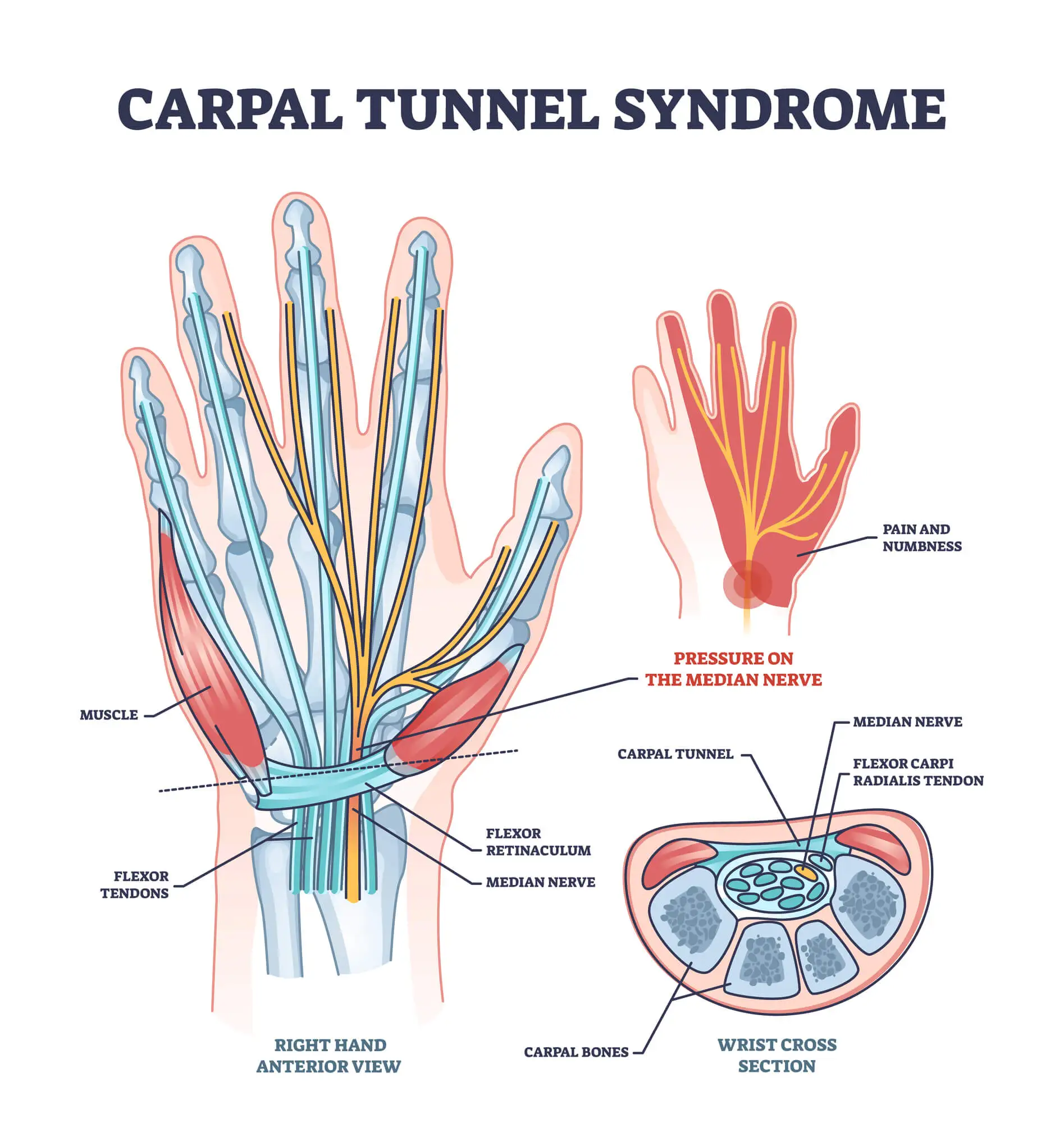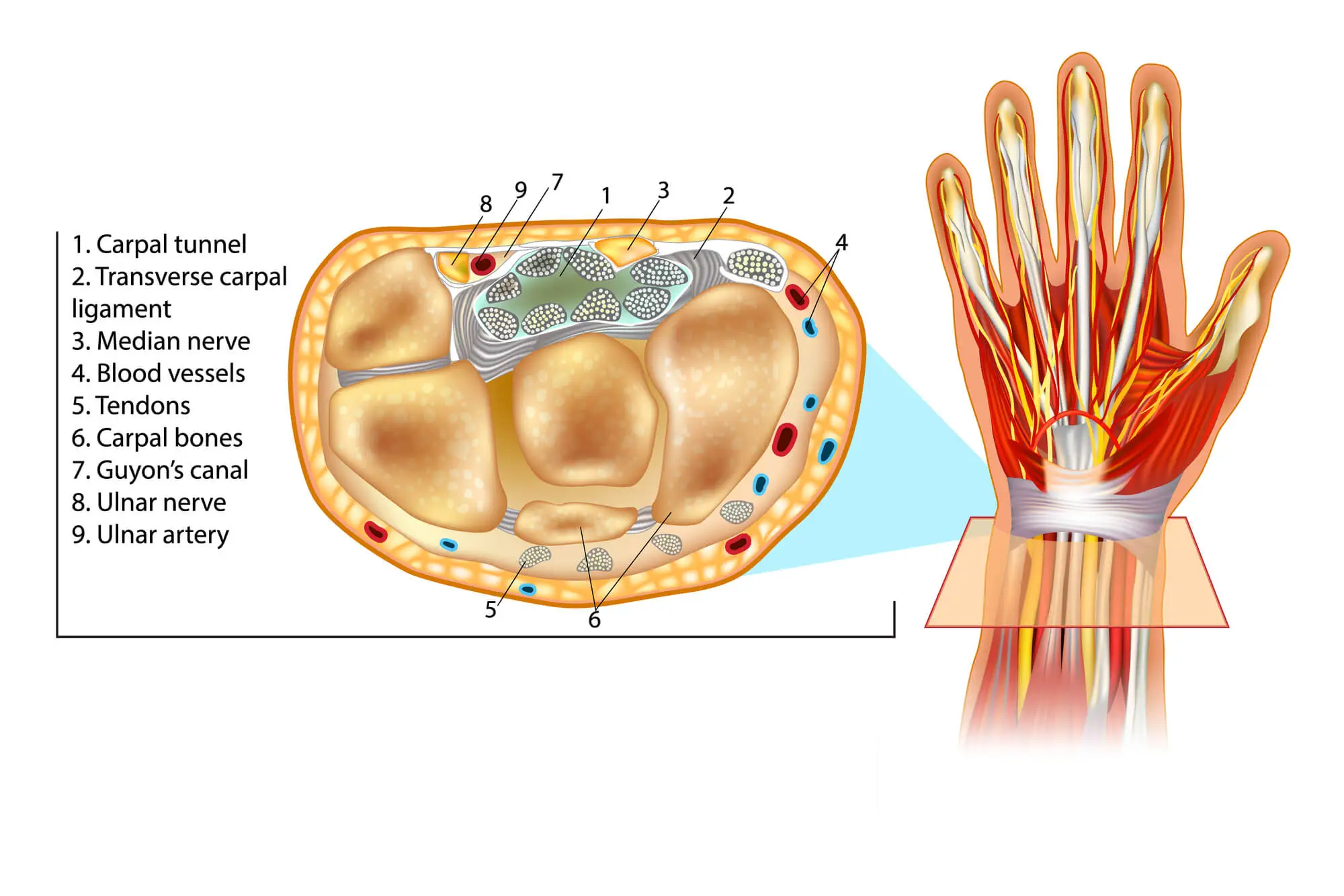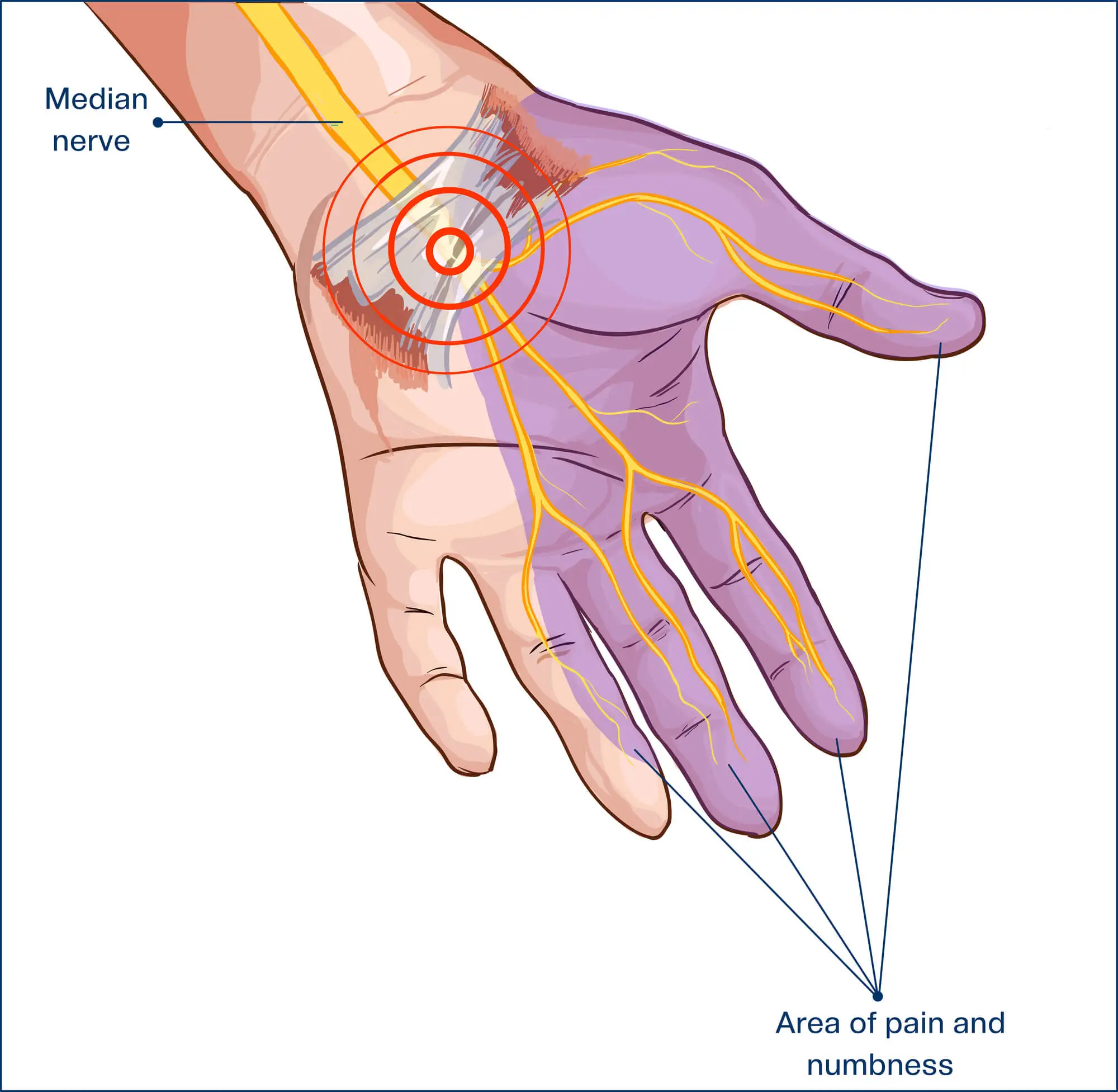Affecting up to 10 million Americans, carpal tunnel syndrome (CTS) is considered to be one of the most common neurological disorders in the US. This condition causes debilitating pain and can impact all aspects of your life, including your ability to work, engage in social activities, and enjoy your favorite hobbies.
To make things worse, for many individuals battling chronic wrist pain, undergoing carpal tunnel release may seem like the inevitable choice to regain their hand and wrist function.
Nonetheless, advances in regenerative medicine are now providing an alternative to taking medications every day or living in fear of needing invasive surgeries. With RELATYV Mobile Pain Management approach, you can regain control over your health without surgeries or medications. Let’s explore how below.
What Is Carpal Tunnel Syndrome?
Carpal tunnel syndrome is a nerve condition that develops when the median nerve in the wrist is compressed, irritated, or damaged.
The median nerve is a nerve located outside of the brain and spinal cord. It is responsible for controlling wrist movements and transmitting signals to the brain regarding muscle movements, sensations, temperature, touch, pain, and vibration.
The median nerve can become compressed when the carpal tunnel, which is a passageway composed of ligaments and tendons located in the wrist, becomes swollen, inflamed, or restricted. Given the fact that this passageway is no more than 20 millimeters wide, even the slightest changes in anatomy can compress the median nerve that runs within it.
The narrowing of the carpal tunnel may be caused by a range of factors, including aging, injuries, repetitive hand motions, obesity, diabetes, inflammatory conditions like arthritis, thyroid disorders, and hormonal changes, such as the ones that occur during pregnancy or menopause.When the median nerve is compressed, it may become irritated or inflamed, which leads to pain, discomfort, swelling, and reduced range of motion. Pressure on this important nerve can also prevent nerve signals from reaching the brain, which results in loss of feeling, numbness, and tingling in the hand.
Depending on the severity of this condition, carpal tunnel syndrome may cause disability, chronic pain, and even irreversible nerve damage.
To better understand carpal tunnel syndrome, let’s look at the anatomy and physiology of the wrist.
Anatomy And Physiology Of The Wrist
The hand and wrist are at the core of most movements we perform every day; from driving, lifting a glass of water, and tying our shoes to working and enjoying our favorite hobbies. And, what makes all of these movements possible is the bundle of nerves, ligaments, tendons, and muscles in the wrist joint. Here’s what you need to know:
- A Little Bit About The Wrist:
The wrist – also known as the radiocarpal joint – is a complex structure that links the forearm to the arm, stabilizes the hand, and allows the movement of our upper extremities.
- Anatomy Of The Wrist:
The wrist is a collection of several joints that connect the forearm bones (radius and ulna, also known as distal joints) to the carpal and metacarpal bones, which are the bones at the base of the hand and palm. These joints are made stable and mobile by several nerves and ligaments that connect the bones to one another, as well as to the hand and wrist muscles.
The carpal tunnel is located in the volar aspect of the wrist or the side of the palm. Small bones called carpal bones function as the floor and sides of the carpal tunnel, while the roof of the tunnel is made of a strong band of connective tissue. This band is known as the transverse carpal ligament.
- Functions Of The Wrist:
As a single joint, the wrist covers the function of providing stability and range of motion to the hand and fingers. However, each component in the wrist and carpal tunnel has its own function. In particular, the median nerve, which is housed in the carpal tunnel, is responsible for controlling the movement and sensory capability of the base of the thumb, middle finger, index finger, and part of the ring finger.

The median nerve stems from a bundle of nerves known as the brachial plexus. The brachial plexus is located outside of the spine and the brain, which makes it part of the peripheral nervous system. The nerves in the brachial plexus, including the median nerve, are responsible for connecting the brain to various extremities and transmitting signals relating to movement, touch, pain, temperature, and vibration. After the wrist portion, the nerve endings stemming from the median nerve branch out onto the hand and fingers.
Symptoms Of Carpal Tunnel Syndrome
Carpal tunnel syndrome affects each person uniquely, and manifests itself with a wide range of symptoms. What’s more, for patients such as pregnant women, CTS is a minor and temporary condition; while for others it can become a source of chronic pain and severe disability.

- Pain in hand and wrist: A narrowing of the carpal tunnel can irritate and inflame the median nerve and surrounding structures, which causes pain and discomfort.
At first, you may experience pain only on certain occasions but, as the condition becomes more severe, the painful sensations can become acute and constant. In people with CTS, the pain is often described as aching, with occasional burning and shock-like sensations.
Over time, the pain may start to radiate from the wrist to the hand and fingers and intensify at night.
- Weakness in the hand: As seen above, the median nerve plays a role in controlling the movements of the hands and fingers. This nerve also allows for pinching and gripping motions and transmits nerve signals relating to the hand’s position within the surrounding space.
When these motor signals are prevented from reaching the brain, you may experience weakness in the hand, loss of pinching strength, and clumsiness (i.e., dropping objects).
- Numbness and tingling sensation in the fingers: electric shock-like and tingling sensations, alongside numbness, are signs that the median nerve is unable to correctly send sensory and pain signals to the brain.
These sensations are particularly noticeable in the part of the hand directly controlled by the median nerve, which includes the thumb and the index, middle, and ring fingers.
Hand Weakness
Experiencing persistent weakness in your hands can significantly impact your quality of life. If you have weakness in your hands, it can be difficult to perform everyday tasks. It can be especially problematic if you use your hands to perform your job. If you...
Muscle Spasm
Muscle spasms are sudden, involuntary contractions of one or more muscles. These contractions can be painful and cause your muscles to tighten up or go into a knot. Muscle spasms can affect any muscle in the body and may last from a few seconds to several...
Numbness And Tingling In Fingers
Experiencing numbness and tingling in the fingers can be quite unsettling. It can feel like a strange sensation that starts with a subtle loss of feeling, followed by a tingling or “pins and needles” effect that can range from mild to intense. Over time,...
Pain In Hand And Wrist
Hand and wrist pain can impact day-to-day activities and make it hard to complete necessary tasks. It may be challenging to grip or lift objects, write, type on a computer, or even perform simple everyday tasks like brushing your teeth. Even the most mundane...
Causes Of Carpal Tunnel Syndrome
In most cases, carpal tunnel syndrome is caused by a combination of factors. However, some causes and risk factors – such as repetitive stress to the hand and wrist, injury, underlying health conditions, and genetic factors – make it more likely.
Let’s look at these factors in more detail below.
Repetitive Hand And Wrist Motions
Repetitive motions, especially when performed over long periods, may put the hand and wrist under excessive or constant pressure. High levels of stress can cause the ligaments and tendons in the carpal tunnel to become irritated, swollen, or inflamed, thus narrowing the passageway that houses the median nerve.
Individuals who are at greater risk of developing CTS include professionals that regularly use vibrating tools, work on an assembly line, or type on a keyboard. Athletes participating in sports that require prolonged hand movements, such as racket sports, archery, rock climbing, and handball, may also be prone to carpal tunnel syndrome.
Injury To The Wrist
Some traumatic injuries that result in a dislocation or fracture of the wrist can lead to changes in the anatomy of the carpal tunnel and misalignments of the wrist joint. These changes can obstruct the carpal tunnel and irritate the median nerve.
Health Conditions
Some health conditions can lead to further inflammation and swelling of the carpal tunnel, thus constricting and damaging the median nerve. You may be at greater risk of developing CTS if you have one or more of the following diagnoses:
- Inflammatory conditions: Inflammatory disorders such as arthritis, rheumatoid arthritis, and osteoarthritis cause the body to sustain high levels of inflammation for prolonged periods.
In turn, excessive inflammation causes the breakdown and damage of the joint’s components. Inflammation also restricts the carpal tunnel because of the build-up of fluids and swelling that it causes.
- Type I and II diabetes: If you have diabetes, spikes and drops in blood sugar levels can damage the blood vessels that supply the median nerve with oxygen and nutrients. This translates into the damage and death of nerve endings, which interferes with normal nerve signaling. Controlling your blood sugar can help you manage this risk factor.
- Hypothyroidism – Some hormonal disorders, such as having an underactive thyroid, may lead to carpal tunnel syndrome. CTS is found in over 16% of people with hypothyroidism, possibly due to the increased Body Mass Index and more severe fluid retention, which causes excessive stress and swelling in the wrist area.
Genetic Factors
Although carpal tunnel syndrome is not an inherited condition, the risk of developing this disorder is greater among those with a close relative diagnosed with CTS.
Additionally, congenital conditions and malformations of the wrist that run in families – such as having a smaller carpal tunnel – can make carpal tunnel syndrome more likely.
Risk Factors
Some risk factors can increase your risk of developing carpal tunnel syndrome, including the following:
- Being female: Females are three times more likely than men to suffer from CTS. That is because women tend to have smaller wrist frames and narrower carpal tunnels. What’s more, the hormonal changes that occur in menopause and pregnancy can increase fluid retention and swelling, which may constrict the median nerve.
- Smoking: Smoking can cause damage to the blood vessels that supply the median nerve with oxygen and nutrients, thus leading to nerve damage. Other substances that are nerve-damaging (neurotoxic) include alcohol, lead, and arsenic.
- Being overweight or obese: Having a high Body Mass Index can increase the build-up of fluids in the carpal tunnel, which leads to swelling and compression of the median nerve. The extra weight may also add stress to the wrist structures. Lastly, obesity is a risk factor in several of the possible causes of carpal tunnel syndrome, including diabetes and arthritis.
Anatomical factors – such as having a slight or small frame – can also increase the risk of carpal tunnel syndrome.
Diagnosis Of Carpal Tunnel Syndrome
If you are experiencing pain, numbness, hand weakness, or tingling sensations in the wrist area, you may have carpal tunnel syndrome. A provider will perform one or more tests to offer an accurate diagnosis. These tests include the following:
- Physical examination: A specialist examination will begin with a review of your medical history and existing conditions. A healthcare provider will also ask about the nature and pattern of your symptoms to exclude other conditions.
For example, if the tingling sensations and numbness occur in your little finger, which is unaffected by the median nerve, you may have a problem other than CTS.
During a physical examination, a doctor will also press on the hand and wrist to determine the source of pain, assess your hand muscles’ strength, and test your ability to feel pressure in the fingers.
- Electromyography (EMG) and nerve conduction studies (NCS): These tests are used to determine the ability of your median nerve to deliver sensory and motor signals to the brain. Using a thin-needle electrode or two electrodes (sticky pads) placed on the wrist, your doctor will apply mild electrical impulses.
As the mild shock navigates from the electrodes to the brain, your doctor will assess whether there are obstructions that cause it to slow down when passing through the median nerve.
- Imaging tests: Imaging tests such as X-rays, ultrasound, and magnetic resonance imaging (MRI) scans provide a visual representation of the inner aspect of the wrist. These tests are used to determine whether there are anatomical abnormalities, arthritis-related wear, and tear, tumors, or physical obstructions in the carpal tunnel.
Conservative Treatment Options For Carpal Tunnel Syndrome
Carpal tunnel syndrome is a condition that develops over time, and finding treatment as soon as possible can slow down the progression of pain and discomfort.
If your discomfort is still mild, you can manage it by taking frequent breaks, avoiding activities that involve hand and wrist movements, and applying cold packs.
If carpal tunnel syndrome is related to the hormonal changes that occur during pregnancy, these conservative treatment options can help you manage your condition until it improves, which usually happens after delivery.
However, if the pain is becoming regular and more intense, you can discuss other conservative treatment options, such as the ones below:
- Rest and immobilization: Rest and immobilization can help reduce inflammation and swelling in the carpal tunnel area, which can decompress the median nerve. Nonetheless, the problem may return as soon as you resume your activities.
An occupational therapist can help you modify your work and sporting activities to reduce the pressure on the wrist.
- Medications: Nonsteroidal anti-inflammatory drugs (NSAIDs), over-the-counter painkillers, and corticosteroid injections can help you manage pain and inflammation in the short term or during flare-ups.
It is important to notice that, if you have chronic pain, taking these medications daily can expose you to severe side effects, including an increased risk of stroke, heart attack, peptic ulcers, and dependency.
- Physical therapy: A physical therapist can help design an exercise program that may strengthen your hand structure and improve wrist flexibility, which can ease the pressure on the median nerve. Nerve gliding exercises, which help the median nerve move more freely within the carpal tunnel, can also help.
- Splinting: Using a splint can help you hold the wrist still when the pain from CTS intensifies, which usually happens at nighttime while using your hands, or typing on a keyboard. This may be a recommended option for pregnant patients because splinting does not involve taking medications.
If carpal tunnel syndrome is caused by another underlying condition, such as diabetes or arthritis, treating these conditions may relieve the symptoms of CTS.
It is important to notice that conservative treatments are most effective when carpal tunnel syndrome is still mild or moderate. If you have constant pain, have been suffering from CTS for more than ten months, or experience numbness, you should look for more efficient treatment options.
Surgical Treatment Options For Carpal Tunnel Syndrome
With nearly half a million carpal tunnel release surgeries performed each year in the US, CTS is considered to be one of the most common hand conditions requiring surgery.
However, surgical interventions for carpal tunnel release are only recommended for advanced cases of CTS or when conservative therapies have not delivered results.
If you are considering this treatment option, make sure to discuss the risks of carpal tunnel release surgeries, which include infections and irreversible damage to the median nerve.
Additionally, be sure to be aware of post-surgery recovery and rehabilitation times, which can stretch to 1 year or more. If you require surgery on your dominant hand, an invasive intervention can significantly delay your return to work.
Some of the most common surgical interventions for carpal tunnel syndrome include the following ones:
- Endoscopic carpal tunnel release: Endoscopic surgery is performed using a telescope-like instrument with an attached camera. This device, which is known as an endoscope, is inserted inside the carpal tunnel via a small incision.
The endoscope is used to carry out a thorough examination of the carpal tunnel and cut a portion of the carpal ligament. This will create more space for the median nerve.
- Open-release surgery: Open carpal tunnel release is used to achieve similar results and ease the pressure on the median nerve.
However, this surgery is highly invasive and requires the surgeon to perform an incision that runs from the palm of the hand to past the wrist. The incision is used to cut through the ligament and free the median nerve. This remains the most used surgery for carpal tunnel.
- Other surgical options: Other surgical options include less invasive and more innovative interventions such as the thread ultrasound-guided carpal tunnel release. This is an incision-less approach that reduces the risk of damage to the median nerve.
Complications Of Carpal Tunnel Syndrome
Leaving carpal tunnel syndrome unaddressed or not taking measures to manage aggravating factors can lead to severe complications.
Firstly, constant pressure and constriction of the median nerve can cause irreversible nerve damage, which can lead to inhibited wrist function and disability.
Additionally, the pain and weakness you experience may make hand movement undesirable. And, if not exercised, the muscles of the hand, wrist, and fingers can shrink and lose mass. This condition, which is called muscle atrophy, may require surgery to prevent irreversible damage.
Other complications of carpal tunnel syndrome include sleep disturbances. 8 in 10 people with CTS experience sleep problems due to the fact that wrist pain intensifies at night.
What’s more, over time, wrist pain and discomfort due to carpal tunnel syndrome can continue to worsen, which causes patients to lose an average of 27 days of work a year. 18% of people who develop CTS are also forced to leave their jobs within 18 months of the start of symptoms.
If CTS does not improve with medications or is causing irreversible damage, surgery may start to appear as the inevitable option. Let’s look at the surgical treatment options for carpal tunnel syndrome below.
RELATYV Mobile Pain Management And Carpal Tunnel Syndrome
If you have moderate or severe carpal tunnel syndrome, you may be struggling with debilitating pain and disability. And, in this case, surgery may seem like the only option.
Fortunately, thanks to advances in medical therapy, you can manage your pain and regain control of your wrist’s function without medications, invasive procedures, or chiropractic treatments.
RELATYV Mobile Pain Management aims to address all aspects and risk factors that may be contributing to your pain and offer a treatment protocol that is non-invasive, non-surgical, non-chiropractic, and drug-free.
Some of the therapies used as part of a RELATYV Mobile Pain Management program include the following:
Electroanalgesia
Electroanalgesia is a pain management technique that uses high-pulse electrical current to ease pain, boost blood circulation, improve mobility, and induce...
IV Therapy
IV nutritional therapy, or intravenous therapy, involves administering vital nutrients directly to the bloodstream through an IV. This type of treatment bypasses the digestive system, allowing for maximum absorption and utilization of nutrients by the...
Lifestyle Counseling
Lifestyle counseling is an approach to managing chronic pain that involves identifying, assessing, and modifying lifestyle factors contributing to an individual's pain. For example, lifestyle factors such as nutrition, physical activity, stress, sleep quality...
Prevention Of Carpal Tunnel Syndrome
Carpal tunnel syndrome may affect anyone, at any age. Some risk factors, such as genetics, a small frame, or menopause, cannot be modified. However, others can be addressed and corrected to reduce your risk of developing carpal tunnel syndrome. Here are some of the key guidelines to follow:
- Proper ergonomics: Working with a specialized lifestyle counselor and occupational health professional can help you understand how your everyday activities are negatively affecting your wrist health. With proper wrist ergonomics, better posture, and activity modification, you can reduce the risk of developing CTS.
- Stretching exercises: Stretching and nerve gliding exercises may help you improve the strength and flexibility of your wrist structures, which can ease the pressure on the median nerve.
- Breaks and rest periods: If your job or sporting activity requires you to use your hands or wrists often, make breaks a priority. Rest periods of 10-15 minutes every hour allow you to stretch your wrist and avoid keeping the carpal tunnel under excessive pressure for too long.
Find Relief With RELATYV
Carpal tunnel syndrome can affect every aspect of your life. Chronic wrist pain can prevent you from being productive at work, enjoy the activities you love, inhibit your athletic performance, and make it harder to complete daily tasks such as tying your shoes, driving, or cooking.
But, today, undergoing surgeries or taking pain medications daily are no longer the only options. A custom RELATYV Mobile Pain Management program can help you regain the health and function of your wrist without drugs or invasive procedures.
Don't let carpal tunnel syndrome control your life. Find relief today.




